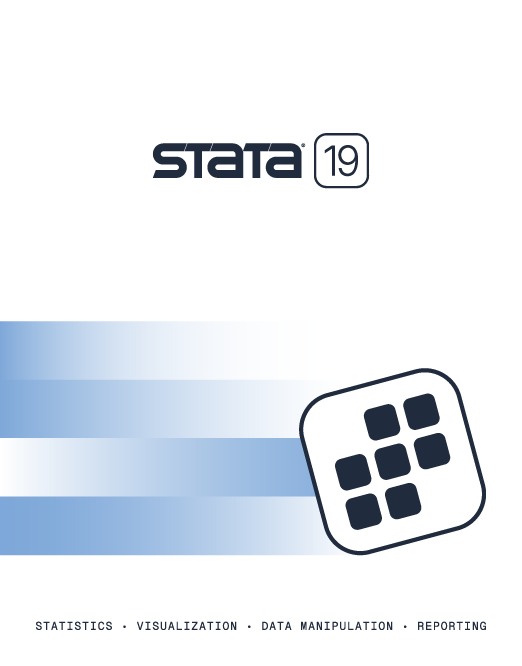
Discover and understand the unobserved groupings
in your data. Use LCA's model-based classification
to find out
- how many groups you have,
- who is in those groups, and
- what makes those groups distinct.
|

Type bayes: in front of any
of 45 Stata estimation commands
to fit a Bayesian regression model.
|
Type this,

Get this,

- Create webpages from Stata
- Intermix text, regressions,
results, graphs, etc.
- See changes in data or commands
automatically reflected on
webpage
|

Write your model in simple
algebraic form. Stata does the
rest: solve model, estimate
parameters, estimate policy and
transition matrices (with CIs),
estimate and graph IRFs, and
perform forecasts.
|

- 17 estimators and combinations
- Continuous, binary, count,
ordinal, categorical, censored,
and truncated outcomes
- Survival outcomes
|
Because
sometimes
where you are
matters.
|

Fit any of Stata's six parametric
survival models to
interval-censored data.
All the usual survival features
are supported: stratified
estimation, robust and clustered
SEs, survey data, graphs, and more.
|

When ...
your science ...
says ...
your model ...
is ...
nonlinear in its parameters
|
|
Do you walk to work, ride a bus, or
drive your car? Which of three
insurance plans do you buy? Which
political party do you vote for?
We make dozens
of choices every day. Researchers
have access to gaggles of data about
those choices. Mixed logit
introduces random effects
into choice modeling and thereby
relaxes the IIA assumption and
increases model flexibility.
|

When you know something matters.
But have no idea how.
|
- Automate your reports
- Write paragraphs and tables
to Word documents
- Embed Stata results and graphs
in paragraphs and tables
- Customize formatting of text, tables, and cells
 | Create PDFs, too! |
|

Small number of groups?
Many hierarchical levels?
Prefer making probability statements?
Consider Bayesian multilevel modeling.
|

Your time-series regression may
change parameters at some point in
time or at multiple points in time.
The activity of foraging animals
might follow a completely different
pattern at temperatures above some
threshold. You may not know the
value of that threshold. Finding
such thresholds and estimating the
parameters within the regimes is
what threshold regression does.
|

Stata has long had estimators
for random effects (random
intercepts) in panel data.
Now you can have random
coefficients, too.
|

The St. Louis Federal Reserve
makes available over 470,000 U.S.
and international economic and
financial time series. You can
now easily search, browse, and
import these data.
|
|
Incomes are sometimes recorded in
groupings, as are people's weights,
insect counts, grade-point averages,
and hundreds of other measures.
Often we have repeated measurements
for individuals, or schools, or
orchards, etc. So ... we need
multilevel regression for
interval-measured (interval-censored)
outcomes.
|
- Left-censoring, right-censoring,
both
- Censoring that varies by
observation
- Make inferences about either
the uncensored or the
censored outcome
- Robust and clustered SEs
- Support for survey data
|

- Tests
- Total of nine variants of tests
|

- Cumulative sum (CUSUM) test for parameter stability
- CUSUM of recursive residuals
- CUSUM of OLS residuals
- Plots with CIs
|
- NCHS's ICD-10-CM diagnosis codes
- CMS's ICD-10-PCS procedure codes
- Verify codes are valid
- Create new variables based on codes
|

Power analysis for comparing
- One- and two-sample means
- One- and two-sample proportions
- Two-sample survivor curves
when you randomize clusters instead of individuals
|

- Solve for
- Power
- Sample size
- Effect size
- Specify lists of
- Alpha values
- Power levels
- Beta values
- Sample sizes
- And more
- Automated tables and graphs
|

- Model for the variance
- Robust and cluster SEs
- Survey-data support
|
|
Counts are common. How many:
Fish did you catch?
Accidents occurred?
Patents does a firm generate?
Outcomes are not always seen.
Folks evade the game warden.
Accidents are not always reported.
Some firms prefer trade secrets to patents.
So you need Poisson models with
sample selection.
|

Of course, many of the new features
are highly parallelized.
|
You can learn about
all of Stata and about
all of Stata's features.





